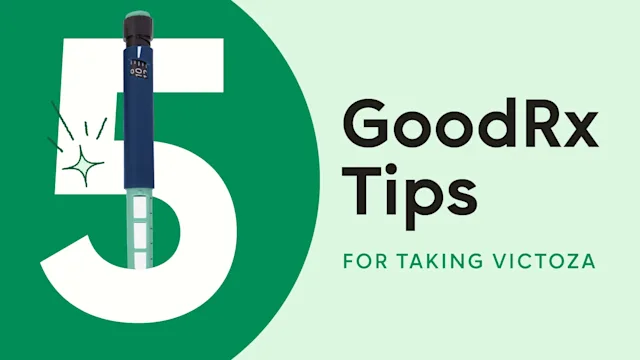Key takeaways:
Victoza (liraglutide) is an injectable, non-insulin Type 2 diabetes medication. It comes as a multi-use, prefilled pen that injects the medication under the skin on the stomach, thigh, or upper arm.
The recommended Victoza starting dosage for adults and children ages 10 and older is 0.6 mg once a day, for at least 1 week. From there, your prescriber will work with you to find the optimal dosage for you. The maximum daily dose is 1.8 mg.
Victoza is available as a brand-name medication. But you can also find it as a lower-cost generic. GoodRx can help make your prescription more affordable.
Save on related medications
When it comes to managing Type 2 diabetes, your prescriber should work closely with you to find the right medication and dosage for your blood sugar (glucose) goals. With some medications — such as Victoza (liraglutide), a once-daily non-insulin injection — this involves starting with a lower dosage and working your way up. This helps reduce side effects and allows you to find the lowest effective dosage.
Though your healthcare team will walk you through your Victoza dosage schedule, you may have questions about typical and maximum Victoza dosages or what to do if you miss your dose. We cover these topics and more below.
What’s the typical Victoza dosage for adults?
Victoza comes in a prefilled, multi-dose pen that you’ll use to inject the medication. You can inject Victoza under the skin in one of three areas: your stomach, thigh, or upper arm.
Victoza pens can inject 0.6 mg, 1.2 mg, or 1.8 mg of medication at a time. So you’ll need to select your prescribed amount when you inject. One Victoza pen should last for 10 to 30 days, depending on your dosage.
Pay close attention to the dosage schedule from your prescriber, since your dosage may change over the first few weeks. You’ll likely start with a low dosage, which will increase over time. Here’s what a typical schedule looks like:
Week 1: The recommended Victoza starting dosage is 0.6 mg injected once daily for 1 week. Starting with a low dosage can help lessen side effects such as nausea and vomiting.
Week 2: After 1 week, the recommended dosage is 1.2 mg once daily.
Week 3 and after: After at least 1 week at 1.2 mg, your prescriber will evaluate how you’re responding to treatment. If you need more help lowering your blood sugar levels, they may increase your dosage to 1.8 mg daily (the maximum dosage).
What’s the typical Victoza dosage for children?
Victoza is also approved for children ages 10 and older who have Type 2 diabetes. The injection instructions for children are the same as those for adults. And the typical dosage schedule is also similar:
Week 1: The recommended Victoza starting dosage for children is 0.6 mg once a day.
Weeks 2 and after: After at least 1 week of treatment, your child’s prescriber will determine how well the 0.6 mg dosage is working. If needed, your child’s dosage may be increased to 1.2 mg once daily. After at least 1 week at 1.2 mg, the dosage could be increased up to the maximum of 1.8 mg daily.
How do you use a Victoza pen?
Victoza pens are designed to be easy to use. But it can take some practice to feel fully comfortable with it.
Before you inject your dose, gather your supplies. You’ll need:
The Victoza pen you’re using
A pen needle
Alcohol swabs
A cotton ball or gauze pad
A sharps container to dispose of your pen needle when you’re finished
The steps below detail the recommended injection instructions for Victoza:
Wash your hands with soap and water for 20 seconds. An alcohol-based hand sanitizer is a good alternative if soap and water are unavailable.
Pull the cap off your Victoza pen. Wipe the rubber stopper with an alcohol swab.
Pull the paper covering off your pen needle.
Push the pen needle onto your Victoza pen. Turn the needle clockwise until it’s tight.
Pull the outer plastic covering off the pen needle. Do not throw this cap away.
Carefully remove the inner needle covering. You can throw this part away in your normal trash.
If this is a new Victoza pen, you’ll need to prime it. To do this, turn the dose selector until you see the flow check symbol, which looks like: (--). Hold the pen with the needle pointing up. Tap the barrel of the pen gently with your finger to bring air bubbles to the top. Press the injector button until the number “0” appears in the dose selector window. Repeat the step up to six times until a drop of liquid appears at the needle tip.
Dial your dose using the dose selector. Watch for your dose (0.6, 1.2, or 1.8) to appear in the window.
Clean your injection site (stomach, thigh, or upper arm) with an alcohol swab. Be sure to use a different alcohol swab than the one you used to wipe your Victoza pen’s rubber stopper. Let it fully air dry. Don’t blow on or fan the area in an attempt to dry it off faster.
Insert the needle into your injection site at a 90-degree angle. Avoid covering the dose counter window while injecting.
Press and hold the injector button until the dose counter reads “0.” Slowly count to six, while continuing to hold the dose button down and keeping the needle in your skin.
Once you’ve counted to six, remove the needle from your skin. Keep holding down on the injector button until you fully remove the needle from your skin. Gently dab the area with a cotton swab or gauze pad.
Carefully place the outer needle cap back on. Twist the pen needle to remove it from the pen. Discard the needle in your sharps container.
What to expect: Starting with a low dose helps limit certain Victoza (liraglutide) side effects. Learn more about these side effects and ways to manage them.
Victoza tips: Explore pharmacist-backed tips for how to get the most from Victoza.
Generic availability: Victoza is now available as a generic product. Here’s what you should know about its launch.
Good to know: If you’re using generic Victoza, called liraglutide, your pen may have different injection instructions than what’s discussed here. Review these instructions with your prescriber or pharmacist before using your liraglutide pen for the first time.
Are there any Victoza dosage adjustments for health conditions or interactions?
With Victoza, your prescriber will adjust your dosage based on how your body responds to the medication. They won’t need to make dosage adjustments based on other health conditions. Though, Victoza isn’t recommended for people with a personal or family history of certain types of thyroid cancer.
But if you take other diabetes medications with Victoza, your prescriber may choose to adjust the dosages of those medications to avoid potential interactions. This may be done when you start treatment with Victoza to lower the risk of low blood sugar (hypoglycemia). Examples of medications that may be adjusted include insulin, sulfonylureas, and meglitinides (glinides).
Even though it’s an injection, Victoza can interact with oral medications. That’s because it slows down how quickly your stomach empties, which may affect how you absorb these medications. Issues haven’t been found with certain oral medications that have been tested with Victoza. But your prescriber may need to adjust your oral medication dosage if it seems to be affected by Victoza.
Make sure your healthcare team has your full medical history and current medication list before you start treatment with Victoza.
What happens if you miss a dose of Victoza?
Victoza is a once-daily medication that can be injected at any time of the day, without regard to meals. But it’s best to inject Victoza at the same time each day so that the medication levels in your body stay consistent.
If you happen to forget your Victoza dose, don’t fret. It’s recommended to skip the missed dose and wait until your next regularly scheduled one. Don’t take an extra or higher dose to make up for a missed one.
If you miss three or more doses of Victoza in a row, talk to your prescriber. They may have you restart Victoza at the lowest dosage to avoid unpleasant side effects. From there, you will gradually increase your dosage until you’re back at your regular dosage.
What should you do if you inject too much Victoza?
Injecting too much Victoza raises your risk of side effects, such as severe nausea and vomiting. Low blood sugar, which can become life-threatening if it’s left untreated, is also possible. Symptoms of low blood sugar include shakiness, a fast heartbeat, and sweating. If you experience these symptoms, follow your healthcare team’s instructions on how to bring your blood sugar levels back up.
Since Victoza pens administer three different dose options, double-check that you’re injecting the correct amount each time. If you’re using a compounded version of Victoza, the risk of injecting too much may be higher. Compounded products usually come in a vial and require you to measure out your specific dose with a syringe.
If you or someone you know takes too much Victoza, reach out to your prescriber or Poison Control at 1-800-222-1222 for guidance. Get immediate medical attention if any symptoms feel severe or life-threatening.
How to save on Victoza
There are ways to save on Victoza, which is available as both a brand-name medication and a lower-cost generic. GoodRx can help you save over 65% off the average retail price of the generic version. Generic liraglutide’s price at certain pharmacies is as low as $238.50 for 3 pens with a free GoodRx discount.
Frequently asked questions
In studies, people using Victoza doses of 1.2 mg or 1.8 mg daily lost between 4 lbs and 6 lbs after 26 weeks (about 6 months). Keep in mind that Victoza isn’t FDA approved for weight loss. But some healthcare professionals may prescribe it off-label for this reason.
However, a higher dose (3 mg) of Victoza, called Saxenda, is approved for weight loss. The typical Saxenda dosage for adults is 3 mg once daily.
The most common side effects of Victoza affect the digestive tract. These include:
Nause
Vomiting
Diarrhea
Smaller appetite
Indigestion
Constipation
Headaches and weight loss are also common with Victoza.
In studies, people using Victoza doses of 1.2 mg or 1.8 mg daily lost between 4 lbs and 6 lbs after 26 weeks (about 6 months). Keep in mind that Victoza isn’t FDA approved for weight loss. But some healthcare professionals may prescribe it off-label for this reason.
However, a higher dose (3 mg) of Victoza, called Saxenda, is approved for weight loss. The typical Saxenda dosage for adults is 3 mg once daily.
The most common side effects of Victoza affect the digestive tract. These include:
Nause
Vomiting
Diarrhea
Smaller appetite
Indigestion
Constipation
Headaches and weight loss are also common with Victoza.
The bottom line
Victoza (liraglutide) is an injectable Type 2 diabetes medication that comes in a prefilled pen. The typical Victoza starting dosage is 0.6 mg once daily. This may be increased up to a maximum dosage of 1.8 mg daily depending on your response. You’ll usually wait at least 1 week in between dosage increases.
If you miss a dose of Victoza, skip it and stick to your usual schedule. Don’t double up on doses to make up for a missed one. However, if you miss at least three doses in a row, talk to your prescriber. They can guide you on what to do next and answer any other questions you have about your Victoza dosage.

Why trust our experts?



References
Novo Nordisk. (2025). Victoza- liraglutide injection.
Novo Nordisk. (2025). Victoza - liraglutide injection 1.2 mg | 1.8 mg [package insert].

















